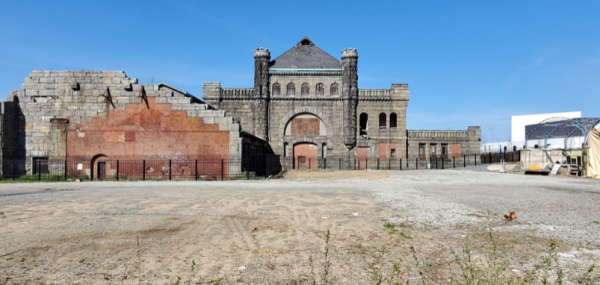April 17, 2024

The iconic Calf Pasture Pumping Station on Columbia Point. Boston Landmarks Commission photo
The Boston Landmarks Commission has recommended that the Calf Pasture Pumping Station on Columbia Point be designated an official Boston landmark. A virtual public hearing will be held next Tuesday (April 23) to consider the proposal for the site, which is already listed on the National Register of Historic Places.
Rosanne Foley, executive director of the BLC, said the designation process entailed “ten registered Boston voters” initially filing the petition in August 2018. A study report released early this month outlined the location’s history and significance to the city.
The pumping station is located on state-owned land at 435 Mt. Vernon St. on what is now the UMass Boston campus. According to the city of Boston’s records, the tax-exempt property is valued at $4.6 million, although its market value is likely much higher.
The university has long indicated that it is interested in re-using the building and surrounding land, potentially for academic purposes. A 2021 “request for proposals” to seek a development partner has to date not resulted in any action on the site. A spokesperson for the UMass Building Authority said this week that the process is “on hold until the Landmarks Commission completes its work,” at which time UMass will “re-assess next steps.”
In the BLC study, the commission said that the Calf Pasture Pumping Station – named so because it was once a grazing field for cows – was built in 1883 and consists of three buildings: the actual pumping station, the Gate House, and the West Shaft Entrance. Altogether, these buildings made up one of the country’s first effective modern sewerage systems, and one of the most wide-reaching, as it was able to divert sewage from 18 cities and towns after the explosion of urban growth between 1830 and 1860.
Before the station was built, an 1872 report from Boston’s Board of Health claimed that “large territories have been at once and frequently enveloped in an atmosphere of stench so strong as to arouse the sleeping, terrify the weak and nauseate and exasperate everybody.”
The site was in use for 85 years until 1968, when the Deer Island Sewage Treatment Plant across the harbor replaced it. The buildings, Romanesque Revival in architectural style, now sit empty, with most of the windows filled in with bricks.
Approval as a landmark would protect the site “from physical changes that might compromise its integrity,” according to the BLC’s website. The commission contends that the site is significant because “the Pumping Station Complex represents significant achievements in technology, social reform, and architectural design in the late 19th century.”
“Anyone can submit feedback about the site under consideration for landmarking: the owner, the commissioners, the general public, anyone opposed to or in favor of landmarking the property within the 21 days prior to the hearing and at the hearing,” Foley said. People can submit comments either at the hearing or at bit.ly/CPPS-Report-Feedback.
Anyone interested in learning more about how the landmark designation process works, Foley said, should visit boston.gov/landmarks.


